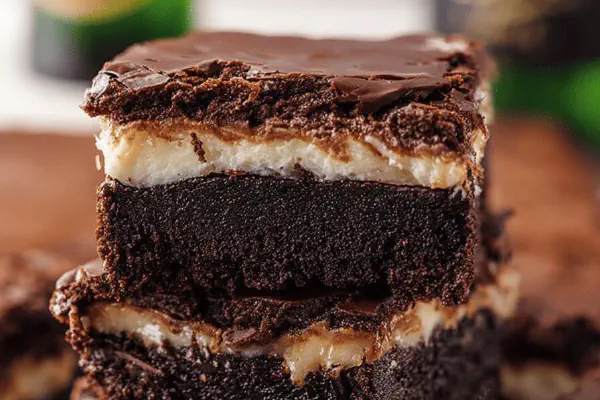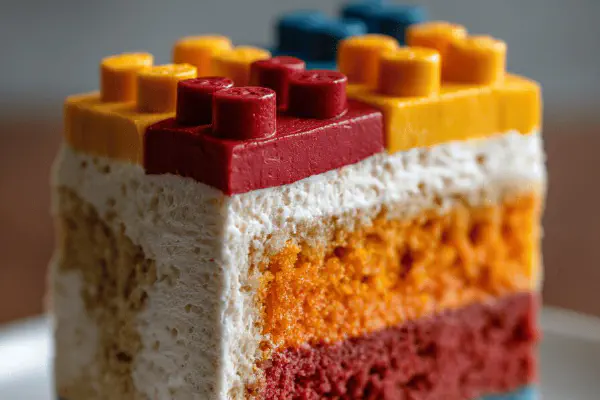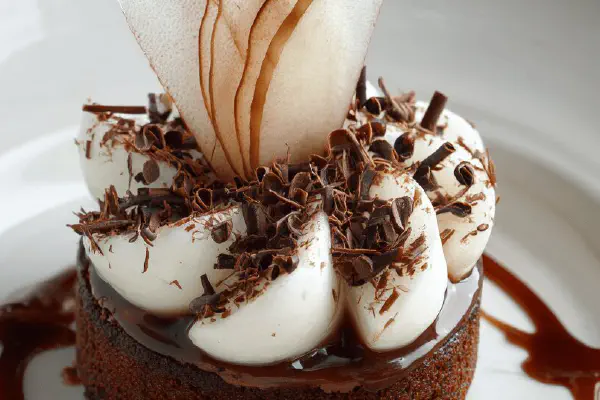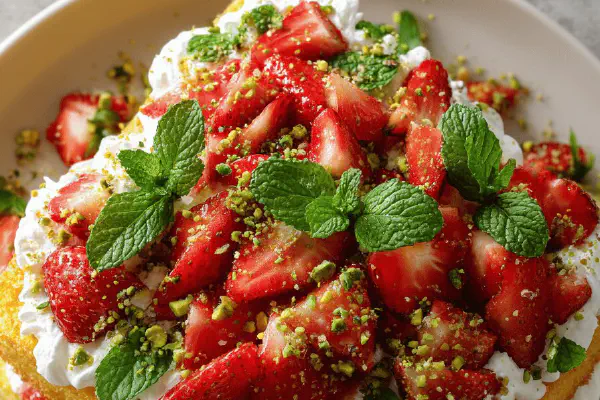Opera Cake Redux
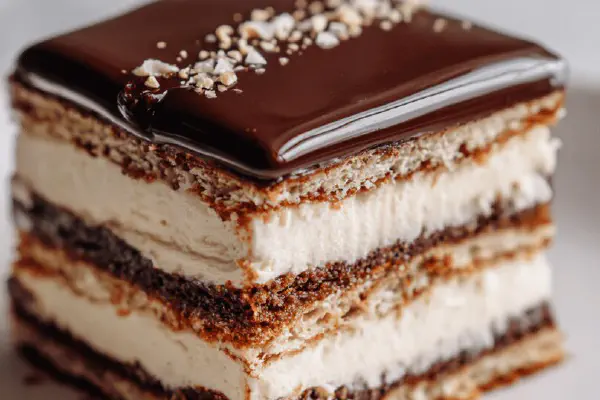
By Emma
Certified Culinary Professional
Ingredients
- 170 ml unbleached all-purpose flour
- 110 ml finely ground hazelnuts
- 3 ml baking powder
- 1 pinch salt
- 3 egg whites, room temp
- 1 pinch cream of tartar
- 150 ml sugar
- 2 whole eggs
- 3 ml vanilla extract
- 12 ml melted unsalted butter, warm
Buttercream
- 2 egg yolks
- 70 ml water
- 110 ml sugar
- 10 ml honey
- 230 ml unsalted butter, room temp
- 3 ml instant espresso powder
- 7 ml hot water
- 20 g melted tempered dark chocolate
- 3 ml vanilla extract
Soaking syrup
- 110 ml strong espresso or decaf, hot
- 25 ml sugar
Ganache
- 50 g bittersweet chocolate, chopped
- 25 ml 35% cream, boiling
About the ingredients
Method
Sponge
- 1. Oven rack centered. Preheat to 175 C. Line a 43 x 30 cm baking tray with parchment leaving two sides overhang for lifting. Butter and dust lightly with flour.
- 2. Whisk together flour, ground hazelnuts, baking powder, salt. Set aside.
- 3. Whip egg whites with cream of tartar until soft peaks form. Gradually add half sugar, beat to firm peaks but not dry. Check texture; should cling but still glossy.
- 4. In separate bowl, beat whole eggs, remaining sugar & vanilla on high until pale, triples volume and ribbons drip slowly from whisk (about 9-11 mins).
- 5. Fold dry mix gently into eggs with spatula - don't deflate too much. Add melted butter in drizzle, fold carefully till just combined. Then fold in meringue in two increments. The batter should be airy, but no streaks.
- 6. Spread batter evenly on tray with offset spatula. Thickness roughly uniform, about 1 cm. Bake 11-13 mins. Surface dry and golden, edges pulling slightly from pan but still tender when poked. Cool fully on rack.
Buttercream
- 7. Separate yolks in large bowl; reserve.
- 8. Combine water, sugar, honey in saucepan. Boil till sugar syrup reaches 105-107 C on candy thermometer or when small bubbles form steadily in thickened syrup (about 3-4 mins).
- 9. Beat yolks on medium speed until frothy. Stream hot syrup slowly into yolks, avoiding whisk blades to prevent splattering. Whip on high 12-15 mins till pale and cool to touch. (Less time if cooler kitchen.)
- 10. Incorporate butter in chunks slowly, beating between additions. Should emulsify into fluffy texture, not greasy. Troubleshoot: if curdled, chill and whip again.
- 11. Divide buttercream equally: flavor one with vanilla extract, one with melted chocolate, one with dissolved espresso (instant coffee + water). Taste each; adjust bitterness or sweetness with small sugar or coffee additions.
Soaking syrup
- 12. Mix hot espresso and sugar until sugar dissolves. Cool slightly before use. Can substitute decaf or strong chicory brew. Adjust sugar for acidity and bitterness of your coffee.
Ganache
- 13. Combine chopped bittersweet chocolate and boiling cream; stir till smooth and glossy. Cool to room temp but not set, spreadable consistency.
Assembly
- 14. Using the parchment edges, lift cake sheet and trim edges for neat 30 x 13 cm strips. Cut into three equal bands.
- 15. Place first strip on serving plate. Brush liberally with soaking syrup, absorbent sponge will take a good soaking but avoid soggy. Spread chocolate buttercream evenly. Layer second strip, soak, spread coffee buttercream. Top with third strip, soak, then vanilla buttercream, smoothing surface with offset spatula.
- 16. Refrigerate at least 25-30 mins to set layers firmly. Optional: trim edges for clean lines.
- 17. Finish by pouring tempered ganache over top, smoothing with spatula for sheen. Chill again until ganache firms up.
- 18. Slice with a hot knife between cuts, wiping blade to avoid crumb drag.
Tips & Notes
- Moisture control critical; if buttercream too soft, chill briefly then rewhip. Swapping almond flour for hazelnut changes flavor and texture; works well if lightly toasted beforehand.
- Use instant espresso powder plus hot water rather than ready espresso to intensify coffee notes.
- If no candy thermometer, watch syrup closely: too short means weak meringue, too long makes brittle meringue and grainy buttercream.
- Frozen cake slices defrosted in fridge maintain structure better than fresh-cut for events.
- Skipping cream of tartar? Lemon juice or vinegar pinch will stabilize whites.
- Ganache temp: too hot melts buttercream; too cool won't spread smoothly.
Cooking tips
Chef's notes
- 💡 Meringue delicate - fold gently. Air wins or you’re staring down pancake texture. Watch sugar syrup bubbles, steady small ones near bead stage; too fast means brittle. Temperature matters; eyeball for syrup sheen and feel for silky mousse stage before adding butter chunks. Butter too cold kills emulsions, too warm breaks mix. Room temp but firm works best.
- 💡 Sponge thin, 1 cm thick; bake till pale golden edges pull slightly but center bounces back; toothpick invites soggy mess. Listen for slight crisp crust sound when tapping gently. Edges cool and shrink signals done; timing varies per oven. Let cool fully before soaking; hot sponge tears easy, cold saves structure but soaks slower.
- 💡 Flavoring buttercream in thirds - fold in melted chocolate, espresso powder dissolved in water, and vanilla last. Taste each batch; adjust sugar or coffee powder bit by bit. Espresso powder better than brewed coffee here; no watering down buttercream texture. Honey swap for corn syrup changes consistency subtly, watch whip speed then.
- 💡 Soaking syrup hot espresso plus sugar till dissolves fully; cool slightly before brushing. Saturate sponge but no puddles or soggy collapse. Decaf or chicory possible. Sugar tweak to cut coffee bitterness or acidity – no candy thermometer? Watch bubbles, look for thick syrup slow bubbling. Heat critical for yolks in buttercream, off temp kills hold and texture.
- 💡 Ganache spread warm not hot – too hot melts buttercream, mess. Cool till thicker but spreadable. Room temp works best. Chill fully to firm layers. Slice sharp knife, heated between cuts, quick wipes stops crumb drag. Freeze before slicing really helps edges hold clean lines but slows serving readiness.
Common questions
Why fold meringue slowly?
Air traps fragile. Rough mixing knocks sweet lightness. Makes dense cake. Folding in increments – key. Keeps volume. No shortcuts.
Can I use almond flour instead hazelnut?
Yes, but flavor shifts. Almond lighter, less deep nuttiness. Toast nuts lightly if possible; raw can dull texture. Swap equal volumes. Beware moisture changes; adjust bake times if needed.
What if sugar syrup overheats?
Buttercream cracks, grainy texture appears. Overcooked syrup makes brittle meringue worse. Start over quickest. If syrup too cool? Buttercream splits, weak hold. Practice temp range 105-107 C. No thermometer? Look for steady bubbles, thick syrup, slow slow slow pour.
How to store layered cake?
Refrigerate tightly wrapped. Can freeze before cutting for cleaner slices. Thaw in fridge overnight. Avoid room temp extended – buttercream softens, ganache sweats. Serve chilled or slight warm depending on room temp.
